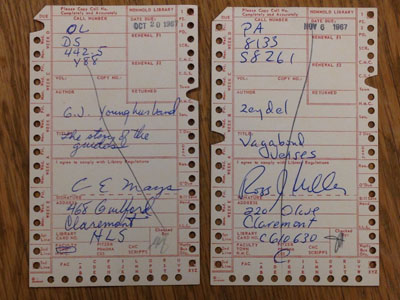Beginning the week with a small trip back to the photo lab, I had the opportunity to start learning about how to use content.dm, which was interesting. While working on the descriptions of the materials that were digitized, I had to read through them in order to find out a proper way to condense the information. Some of the materials were an eye-opener into the way negotiations were made between Willis S. Jones and the owners of lands across the Los Angeles County through which some of the major pipelines and pumping plants were built.
An Unusual Turn
New Discoveries!
This
week, I came across two library cards from the Honnold-Mudd Library dated back
to 1967! Considering the technological developments that have taken place
around us, it was fascinating to see an old library card, where the borrower
had to mention everything on paper, every time they borrowed a book. Looking
closely, one could see the mention of the Claremont Colleges from which the
borrower had to choose. Being a Claremont Graduate University (CGU) student, it
was interesting to learn that CGU used to be named as the Claremont Graduate
School (as mentioned in the card).
Coming
back to the digitization project, this week I worked on materials by Willis S.
Jones that focused solely on building of pipelines and pumping plants. Going
through the materials, I was able to understand that the process consisted of
preparing examination reports of the regions, drawing sketch maps of the plants
and pipelines, checking reports from the Los Angeles County Flood Control
District and preparing reports of rainfall and discharge measurements along with
the required mathematical calculations.

Normal
0
false
false
false
EN-US
X-NONE
X-NONE
/* Style Definitions */
table.MsoNormalTable
{mso-style-name:”Table Normal”;
mso-tstyle-rowband-size:0;
mso-tstyle-colband-size:0;
mso-style-noshow:yes;
mso-style-priority:99;
mso-style-parent:””;
mso-padding-alt:0in 5.4pt 0in 5.4pt;
mso-para-margin:0in;
mso-para-margin-bottom:.0001pt;
mso-pagination:widow-orphan;
font-size:12.0pt;
font-family:”Calibri”,”sans-serif”;
mso-ascii-font-family:Calibri;
mso-ascii-theme-font:minor-latin;
mso-hansi-font-family:Calibri;
mso-hansi-theme-font:minor-latin;}
Back to Base!
One of the elements that played a key role in determining water supply to a majority of the cities in California between 1918 and 1930 was the distribution of water that was conserved from rainfall. Digitizing rainfall records from various places such as Santa Rosa, the Tenaja Station, the Pauba Ranch and the Nigger Canyon gave me a perspective on how water was distributed to various parts of California based on the regions’ seasonal rainfall. Regions with higher rainfall records would get lesser supply over a year compared to ones where the weather was mostly dry. Letters sent between the Los Angeles Chamber of Commerce and Willis S. Jones was an eye-opener as to how the prices were negotiated.